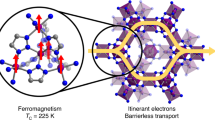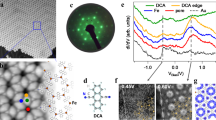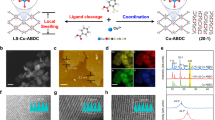Abstract
For over two decades there have been intense efforts aimed at the development of alternatives to conventional magnets, particularly materials comprised in part or wholly of molecular components1,2. Such alternatives offer the prospect of realizing magnets fabricated through controlled, low-temperature, solution-based chemistry, as opposed to high-temperature metallurgical routes, and also the possibility of tuning magnetic properties through synthesis. However, examples of magnetically ordered molecular materials at or near room temperature are extremely rare3, and the properties of these materials are often capricious and difficult to reproduce. Here we present a versatile solution-based route to a new class of metal–organic materials exhibiting magnetic order well above room temperature. Reactions of the metal (M) precursor complex bis(1,5-cyclooctadiene)nickel with three different organics A—TCNE (tetracyanoethylene), TCNQ (7,7,8,8-tetracyanoquinodimethane) or DDQ (2,3-dichloro-5,6-dicyano-1,4-benzoquinone)—proceed via electron transfer from nickel to A and lead to materials containing Ni(II) ions and reduced forms of A in a 2:1 Ni:A ratio—that is, opposite to that of conventional (low Curie temperature) MA2-type magnets. These materials also contain oxygen-based species within their architectures. Magnetic characterization of the three compounds reveals spontaneous field-dependent magnetization and hysteresis at room temperature, with ordering temperatures well above ambient. The unusual stoichiometry and striking magnetic properties highlight these three compounds as members of a class of stable magnets that are at the interface between conventional inorganic magnets and genuine molecule-based magnets.
This is a preview of subscription content, access via your institution
Access options
Subscribe to this journal
Receive 51 print issues and online access
$199.00 per year
only $3.90 per issue
Buy this article
- Purchase on Springer Link
- Instant access to full article PDF
Prices may be subject to local taxes which are calculated during checkout



Similar content being viewed by others
References
Kahn, O. Molecular Magnetism (VCH, New York, 1993)
Miller, J. S. Organometallic- and organic-based magnets: New chemistry and new materials for the new millennium. Inorg. Chem. 39, 4392–4408 (2000)
Miller, J. S. & Epstein, A. J. Molecule-based magnets—an overview. MRS Bull. 25, 21–28 (2000)
Ferlay, S., Mallah, T., Ouahes, R., Veillet, P. & Verdaguer, M. A room-temperature organometallic magnet based on Prussian blue. Nature 378, 701–703 (1995)
Manriquez, J. M., Yee, G. T., McLean, R. S., Epstein, A. J. & Miller, J. S. A room temperature molecular/organic based magnet. Science 252, 1415–1417 (1991)
Miller, J. S. & Epstein, A. J. Tetracyanoethylene-based organic magnets. Chem. Commun. 1319–1325 (1998)
Fitzgerald, J. P., Kaul, B. B. & Yee, G. T. Vanadium [dicyanoperfluorostilbene]2⋅yTHF: a molecule-based magnet with TC ≈ 205 K. Chem. Commun.49–50 (2000)
Vickers, E. B., Selby, T. D. & Miller, J. S. Magnetically ordered (TC=200 K) bis(tetracyanopyrazine)vanadium, V[TCNP]2⋅yCH2Cl2 . J. Am. Chem. Soc. 126, 3716–3717 (2004)
Zhang, J. et al. [M-II(tcne)2].xCH2Cl2 (M=Mn, Fe, Co, Ni): molecule-based magnets with TC values above 100K and coercive fields up to 6500Oe. Angew. Chem. Int. Edn Engl. 37, 657–660 (1998)
Pokhodnya, K. I., Petersen, N. & Miller, J. S. Iron pentacarbonyl as a precursor for molecule-based magnets: Formation of Fe[TCNE]2 (TC=100 K) and Fe[TCNQ]2 (TC=35 K) magnets. Inorg. Chem. 41, 1996–1997 (2002)
Vickers, E. B., Senesi, A. & Miller, J. S. Ni[TCNE]2⋅zCH2Cl2 (TC=13 K) and VxNi1-x[TCNE]y⋅zCH2Cl2 solid solution room temperature magnets. Inorg. Chim. Acta 357, 3889–3894 (2004)
Kathirgamanathan, P. & Rosseinsku, D. R. Electrocrystallized metal-tetracyanoquinodimethane salts with high electrical conductivity. J. Chem. Soc. Chem. Commun.840–841 (1980)
Ferraro, J. R. & Williams, J. M. Introduction to Synthetic Electrical Conductors (Academic Press, New York, 1987)
Clerac, R. et al. Glassy magnets composed of metals coordinated to 7,7,8,8-tetracyanoquinodimethane: M(TCNQ)2 (M = Mn, Fe, Co, Ni). Chem. Mater. 15, 1840–1850 (2003)
Long, G. & Willett, R. D. Electrochemical synthesis, characterization and magnetic studies of Ni/TCNQ salts. Inorg. Chim. Acta 313, 1–14 (2001)
Osan, J. et al. Evaluation of energy-dispersive x-ray spectra of low-Z elements from electron-probe microanalysis of individual particles. X-ray Spectrom. 30, 419–426 (2001)
Kaim, W. & Moscherosch, M. The coordination chemistry of TCNE, TCNQ, and related polynitrile pi-acceptors. Coord. Chem. Rev. 129, 157–193 (1994)
Miller, J. S. & Dixon, D. A. Dianion stabilization by M(C5(CH3)5)2)+—theoretical evidence for a localized ring in (DDQ)2-. Science 235, 871–873 (1987)
Murphy, V. J. & O’Hare, D. Synthesis and magnetic characterization of Fe(η5-C9Me7)2⋅+A•- (A = TCNE, TCNQ, DDQ)—X-ray structure of Fe(η5-C9Me7)2⋅+TCNQ•-. Inorg. Chem. 33, 1833–1841 (1994)
Miller, J. S. et al. Radical ion salts of 2,3-dichloro-5,6-dicyanobenzoquinone and metallocenes—a reexamination of their magnetic and spectroscopic properties. J. Am. Chem. Soc. 108, 4459–4466 (1986)
Vickers, E. B., Giles, I. D. & Miller, J. S. M[TCNQ]x-based magnets (M = Mn, Fe, Co, Ni; TCNQ=7,7,8,8-tetracyano-p-quinodimethane). Chem. Mater. 17, 1667–1672 (2005)
Bell, S. E. et al. Novel and stable metal-metal-bonded diruthenium(I) complexes containing TCNX0/•- in both the inner and the outer coordination sphere (TCNX = TCNE, TCNQ)—a combined EPR/ENDOR spectroscopic, UV/vis/near-IR spectroscopic, and IR spectroscopic and electrochemical investigation. Inorg. Chem. 31, 3269–3276 (1992)
Yang, D. Q. & Sacher, E. Interaction of evaporated nickel nanoparticles with highly oriented pyrolytic graphite: Back-bonding to surface defects, as studied by x-ray photoelectron spectroscopy. J. Phys. Chem. B 109, 19329–19334 (2005)
Buschmann, W. E., Ensling, J., Gütlich, P. & Miller, J. S. Electron transfer, linkage isomerization, bulk magnetic order, and spin-glass behavior in the iron hexacyanomanganate Prussian blue analogue. Chem. Eur. J. 5, 3019–3028 (1999)
Pokhodnya, V. I., Pejakovic, D., Epstein, A. J. & Miller, J. S. Effect of solvent on the magnetic properties of the high-temperature V[TCNE]x molecule-based magnet. Phys. Rev. B 63, 174408 (2001)
Schrauzer, G. N. & Thyret, H. Novel “sandwich” compounds of nickel(0); duroquinone-nickel(0) complexes with cyclic dienes. Z. Naturforsch. 17b, 73–76 (1962)
Leslie-Pelecky, D. L. & Rieke, R. D. Magnetic properties of nanostructured materials. Chem. Mater. 8, 1770–1783 (1996)
Koltypin, Y. et al. Encapsulation of nickel nanoparticles in carbon obtained by the sonochemical decomposition of Ni(C8H12)2 . Chem. Mater. 11, 1331–1335 (1999)
Cordente, N. et al. Synthesis and magnetic properties of nickel nanorods. Nano Lett. 10, 565–568 (2001)
Khadar, M. A., Biju, V. & Inoue, A. Effect of finite size on the magnetization behavior of nanostructured nickel oxide. Mater. Res. Bull. 38, 1341–1349 (2003)
Acknowledgements
We thank the Natural Sciences and Engineering Research Council of Canada and the University of Victoria for support of this research. We thank F. Palacio (Zaragoza) for assistance with some magnetic measurements and B. Gowen (Victoria) for assistance in scanning TEM and EDX measurements.
Author Contributions R.J. and R.G.H contributed equally to this work. R.J. initiated the work under the supervision of R.G.H. R.J. performed all the syntheses, control experiments, characterization, SEM and EDX measurements of the magnets. K.K. attempted to crystallize these materials, assisted in some control experiments and also processed the magnetic, X-ray photoelectron spectroscopic data. J.B.G. performed some magnetic measurements. K.A.R.M. and K.W. conducted the X-ray photoelectron spectroscopic studies. R.J. and R.G.H. wrote the manuscript. All authors have discussed the results presented and commented on the paper.
Author information
Authors and Affiliations
Corresponding author
Ethics declarations
Competing interests
Reprints and permissions information is available at www.nature.com/reprints. The authors declare no competing financial interests.
Supplementary information
Supplementary Information
This file contains Supplementary Methods; Supplementary Data and Supplementary Figures 1-10 with legends. This file contains descriptions of materials & techniques; compositional analyses data; and spectroscropic data (infrared spectra, 3 figures; solid state electronic spectra, 4 figures; XPS spectra, 6 figures; magnetic data, 13 figures; SEM images, 3 figures; EDX images and spectra, 9 figures; TEM images, 3 figures). (PDF 2229 kb)
Rights and permissions
About this article
Cite this article
Jain, R., Kabir, K., Gilroy, J. et al. High-temperature metal–organic magnets. Nature 445, 291–294 (2007). https://doi.org/10.1038/nature05439
Received:
Accepted:
Issue Date:
DOI: https://doi.org/10.1038/nature05439
This article is cited by
-
Extraction of magnetic circular dichroism effects from blended mixture of magnetic linear dichroism signals in the cobalt/Scotch tape system
Scientific Reports (2019)
-
Magnetic metal-complex-conducting copolymer core–shell nanoassemblies for a single-drug anticancer platform
NPG Asia Materials (2017)
-
Towards Rectifying Performance at the Molecular Scale
Topics in Current Chemistry (2017)
-
Abnormal Magnetic Field Effects on Electrogenerated Chemiluminescence
Scientific Reports (2015)
-
High-temperature antiferromagnetism in molecular semiconductor thin films and nanostructures
Nature Communications (2014)
Comments
By submitting a comment you agree to abide by our Terms and Community Guidelines. If you find something abusive or that does not comply with our terms or guidelines please flag it as inappropriate.



